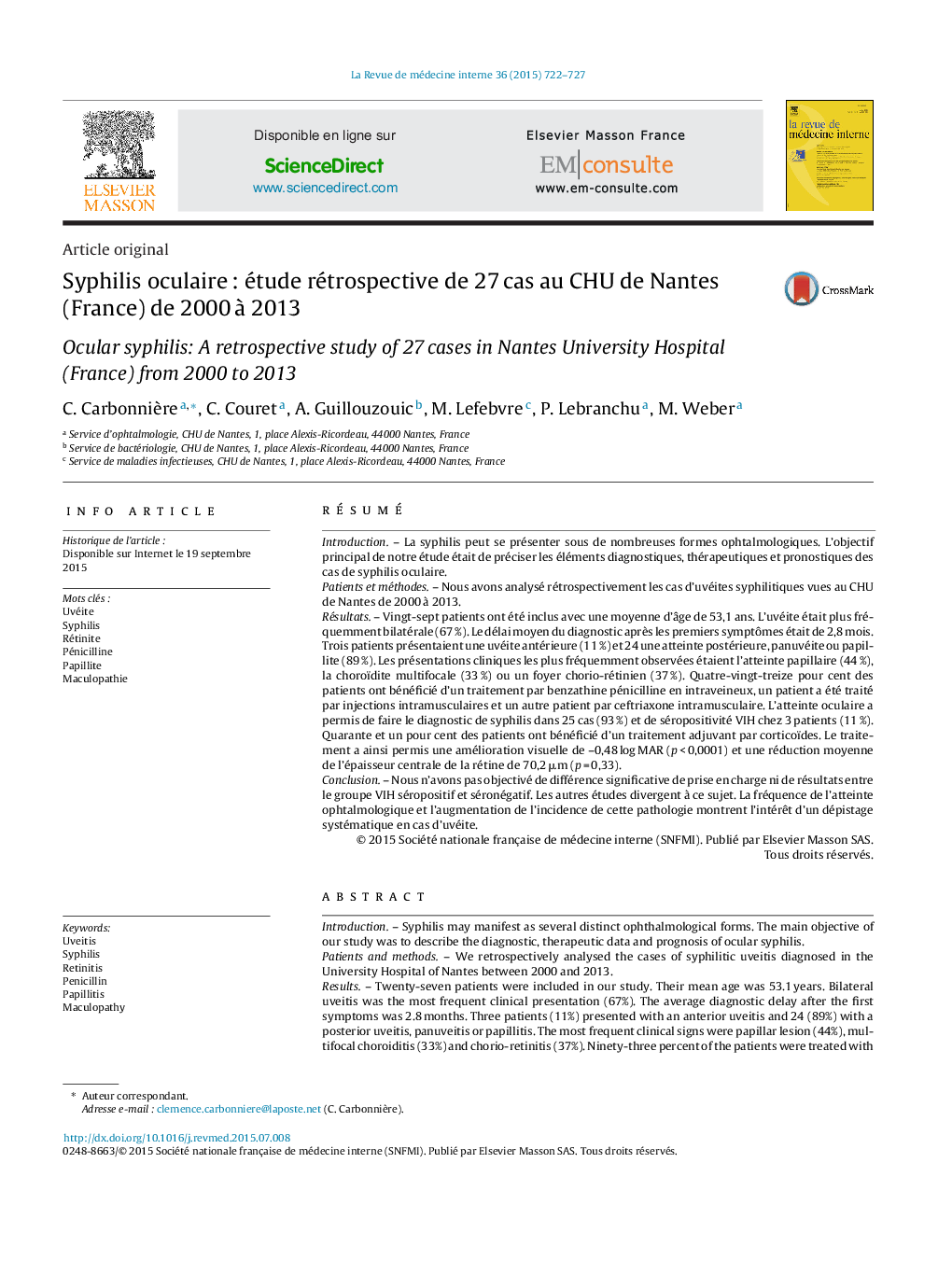| کد مقاله | کد نشریه | سال انتشار | مقاله انگلیسی | نسخه تمام متن |
|---|---|---|---|---|
| 5999784 | 1182350 | 2015 | 6 صفحه PDF | دانلود رایگان |

RésuméIntroductionLa syphilis peut se présenter sous de nombreuses formes ophtalmologiques. L'objectif principal de notre étude était de préciser les éléments diagnostiques, thérapeutiques et pronostiques des cas de syphilis oculaire.Patients et méthodesNous avons analysé rétrospectivement les cas d'uvéites syphilitiques vues au CHU de Nantes de 2000 à 2013.RésultatsVingt-sept patients ont été inclus avec une moyenne d'âge de 53,1 ans. L'uvéite était plus fréquemment bilatérale (67 %). Le délai moyen du diagnostic après les premiers symptômes était de 2,8 mois. Trois patients présentaient une uvéite antérieure (11 %) et 24 une atteinte postérieure, panuvéite ou papillite (89 %). Les présentations cliniques les plus fréquemment observées étaient l'atteinte papillaire (44 %), la choroïdite multifocale (33 %) ou un foyer chorio-rétinien (37 %). Quatre-vingt-treize pour cent des patients ont bénéficié d'un traitement par benzathine pénicilline en intraveineux, un patient a été traité par injections intramusculaires et un autre patient par ceftriaxone intramusculaire. L'atteinte oculaire a permis de faire le diagnostic de syphilis dans 25 cas (93 %) et de séropositivité VIH chez 3 patients (11 %). Quarante et un pour cent des patients ont bénéficié d'un traitement adjuvant par corticoïdes. Le traitement a ainsi permis une amélioration visuelle de -0,48 log MAR (p < 0,0001) et une réduction moyenne de l'épaisseur centrale de la rétine de 70,2 μm (p = 0,33).ConclusionNous n'avons pas objectivé de différence significative de prise en charge ni de résultats entre le groupe VIH séropositif et séronégatif. Les autres études divergent à ce sujet. La fréquence de l'atteinte ophtalmologique et l'augmentation de l'incidence de cette pathologie montrent l'intérêt d'un dépistage systématique en cas d'uvéite.
IntroductionSyphilis may manifest as several distinct ophthalmological forms. The main objective of our study was to describe the diagnostic, therapeutic data and prognosis of ocular syphilis.Patients and methodsWe retrospectively analysed the cases of syphilitic uveitis diagnosed in the University Hospital of Nantes between 2000 and 2013.ResultsTwenty-seven patients were included in our study. Their mean age was 53.1 years. Bilateral uveitis was the most frequent clinical presentation (67%). The average diagnostic delay after the first symptoms was 2.8 months. Three patients (11%) presented with an anterior uveitis and 24 (89%) with a posterior uveitis, panuveitis or papillitis. The most frequent clinical signs were papillar lesion (44%), multifocal choroiditis (33%) and chorio-retinitis (37%). Ninety-three percent of the patients were treated with benzathine penicillin intravenously, one patient was treated by intramuscular penicillin injections and another by ceftriaxone intramuscularly. Ocular manifestations alone were sufficient to make the diagnosis of syphilis in 25 patients (93%) and of HIV seroconversion in 3 patients (11%). Forty-one percent of the patients benefited from an adjuvant therapy with corticosteroids. The treatment allowed a visual improvement of -0.48 log MAR (P < 0.0001) with an average reduction of retinal central thickness of 70.2 μm (P = 0.33).ConclusionWe did not find a significant difference neither in management nor in results between the HIV seropositive and HIV seronegative groups. Others studies remains controversial about this aspect. The increased frequency of ocular manifestation as well as the increase of syphilis makes systematic screening in uveitis of a great value.
Journal: La Revue de Médecine Interne - Volume 36, Issue 11, November 2015, Pages 722-727